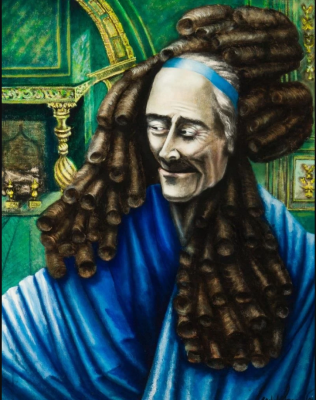Leibniz’s Peruke
On the Philosophical Importance of Fake Hair
Richard Halpern

Possessed of a monumentally impressive intellect, the philosopher and mathematician Gottfried Wilhelm Leibniz (1646–1716) was not blessed with a body to match. Bald, short, and unhandsome of feature, he accordingly availed himself of that universal male cosmetic—and prosthetic—of his era, the peruke (figure 1). Leibniz’s peruke ameliorated several bodily shortcomings: it covered his bald pate, including a bony growth the size of a pigeon’s egg that purportedly sat there; it added several inches to his height; and it did not so much frame his face as distract attention from it.
Leibniz was hardly the only seventeenth-century philosopher to sport a wig: René Descartes and John Locke did so as well. Theirs were not quite so extravagant and luxurious as Leibniz’s, however, nor did they give quite the same impression that a poodle had curled up for a nap on the wearer’s head. In the portrait reproduced here, by the fashionable court painter Christoph Bernhard Francke, Leibniz’s peruke complements the rich velvet folds of his garment to project an aura of prosperity, prestige, and fashion. Leibniz, who was fond of perfume as well as of perukes, made no bones about his wish to be included in polite society. The duke of Orleans was sufficiently impressed with his elegance to declare: “It is unusual for intellectuals to dress well, not to smell bad, and to understand jokes.”[i]
Leibniz’s peruke silently poses questions: Should philosophers concern themselves with reputation, physical appearance, and fashion in the way that Leibniz does? Shouldn’t the philosopher focus rather on the disinterested pursuit of truth? Ever since Diogenes the Cynic, poverty and simplicity have served as emblems of philosophical authenticity. If we no longer demand that our philosophers be poor, we expect at least a certain slovenliness—a sign that their attention is directed elsewhere, upon more fundamental matters, and not on their appearance.
John Locke seems to make a related point in the dedicatory epistle to An Essay Concerning Human Understanding: “The Imposition of Novelty is a terrible Charge among those, who judge of Men’s Heads as they do their Perukes, by the Fashion; and can allow none to be right, but the received Doctrines.”[ii] The philosopher is supposed to be defined by what goes on in his or her head, not by what is perched upon it. Philosophers pursue truth, but the wig is an emblem of falsehood. The philosopher investigates eternal verities, but the wig occupies the ephemeral realm of fashion. In The Wig: A Harebrained History (London: Reaktion, 2020), Luigi Amara posits the wig as the supremely antiphilosophical object, more at home with the deceptive rhetorical chicanery of the Sophists (and for that reason also a supreme philosophical provocation).
Leibniz’s peruke silently poses questions: Should philosophers concern themselves with reputation, physical appearance, and fashion in the way that Leibniz does?
But if philosophy and wigs are conceptually incompatible, this fact did not seem to bother Leibniz, who was perfectly comfortable with both. I would like to suggest, indeed, that the wig takes on enhanced significance if juxtaposed not only to philosophy in general but also to Leibniz’s philosophy in particular. One of the things Leibnizian metaphysics does is take Cartesian dualism and push it to an extreme: bodies and minds not only are of essentially different natures, as Descartes held, but also because of this they do not interact at all. But if bodies and minds cannot affect one another causally, Lebiniz argued, they nevertheless express each other. Every mental event is accompanied by some change in the bodily state of the entity experiencing it and vice versa. These expressive relations are not the result of direct mutual influence but are created by God as part of what Leibniz called pre-established harmony. In place of causal relations between mind and body, then, Leibniz posits something more like aesthetic ones.
Leibniz’s philosophy would claim, therefore, that his own bodily appearance is not unrelated to what goes on in his head. Indeed, his body expresses his mind and vice versa, though the ways in which it does so may be difficult to construe. But does the supplement or prosthetic that is the wig take part in this expressive relation? The wig is not “really” or naturally part of the body and would thus seem in this respect to be excluded from the expressive relation. Yet, as I have been suggesting, Leibniz’s peruke offers eloquent testimony to aspects of his mental constitution. Certainly, it tells us more about him than do his nose or ears or arms or other bodily parts.
Leibniz’s philosophy would claim, therefore, that his own bodily appearance is not unrelated to what goes on in his head.
Is the wig merely exterior to Leibniz’s body, or is it part of it? The prosthesis blurs the boundaries between these alternatives and reminds us that the human body can incorporate the artificial as well as the natural—especially so if the unity of the body is conceived of as expressive. Would we recognize Leibniz’s portrait if he were depicted without his ubiquitous, distinctive peruke? In some sense he would cease to be himself without it. If it is Leibniz who wears the peruke, it is equally true that the peruke wears Leibniz.
As proof of this, the peruke goes on to pursue its own existence once Leibniz is gone and even achieves an independent if minor form of celebrity. Exhibit A: an article in the 1902 edition of the Zeitschrift für Ethnologie entitled “Schädel von Leibniz” (Leibniz’s skull).The author, one Professor W. Krause, considers the authenticity of a skull supposed to be Leibniz’s. Among the “tests” he runs is to take an old engraving of Leibniz’s peruke, superimpose a photograph of the skull upon it, and see if it fits (figure 2). Here the wig, traditionally an emblem of falsehood and deception, becomes the arbiter of truth. Like Cinderella’s slipper, it has the power to declare its one true owner. Who is Leibniz? The one who fits Leibniz’s wig. And the image incidentally recalls the painterly theme of vanitas, another revelation of truth, as it depicts a Leibniz carrying his pretensions into the grave.
Exhibit B: a painting titled Voltaire ou La perruque de Leibniz (1967), by the Belgian surrealist artist Rachel Baes, forms part of a series subjecting each of the great rationalist philosophers of the seventeenth century to deflatingly “irrationalist” treatment (figure 3). Baes, for instance, punningly turns L’éthique de Spinoza into Les tics de Spinoza and paints the Dutch philosopher in full facial spasm. In the case of Voltaire ou La perruque de Leibniz, Baes does not depict Leibniz directly but rather drapes his famed peruke, none too carefully, on the head of Voltaire. Via the character of Dr. Pangloss, Voltaire’s novel Candide had famously derided Leibniz’s contention that ours is “the best of all possible worlds,” and here Baes appears to be returning the favor. Leibniz’s peruke continues its role as Cinderella’s slipper, declaring Voltaire as false owner since it fits him so badly. (Baes may also be playing on the slang meaning of “la perruque” as goofing off at work.) No longer a mere adornment, Leibniz’s peruke has become a mocking philosophical crown. Perhaps, the painting suggests, any subsequent philosopher worthy of the name must henceforth don the peruke of Leibniz as a trial of worthiness. Care to try it on, reader?
Richard Halpern is the author of Leibnizing: A Philosopher in Motion. At his retirement, he was Erich Maria Remarque Professor of Literature at New York University.
Categories:Author-Editor Post/Op-EdPhilosophy







